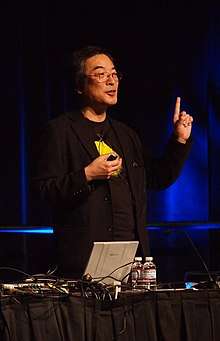Toru Iwatani
| Toru Iwatani | |
|---|---|
 Iwatani at the Game Developers Conference in 2011 | |
| Native name | 岩谷徹 |
| Born |
Toru Iwatani January 25, 1955 Meguro, Tokyo, Japan |
| Nationality | Japanese |
| Occupation | Video game designer |
| Known for |
Pac-Man Pole Position |
Toru Iwatani (岩谷 徹 Iwatani Tōru, born January 25, 1955) is a Japanese video game designer, best known as the creator of the arcade games Pac-Man (1980) and Pole Position (1982).
Early life
Iwatani was born in Meguro ward of Tokyo, Japan. He was self-taught, without any formal training in computers, visual arts, or graphic design.[1] For example, he filled his school textbooks with scattered manga, which went on to influence the character designs in his video games.[2]
Career
He joined the computer software company Namco in 1977.[1] This was where he started his career in the video game business. There, he came up with the idea for a game called "Pakku-Man" and in 1980, he, along with programmer Shigeo Funaki (舟木 茂雄), a hardware engineer, a cabinet designer and Toshio Kai (甲斐 敏夫) for sound and music, finished the game. It was released to the Japanese public on May 22 of that year, where it became a huge success. It caught the attention of arcade-game manufacturer Midway, who bought the United States rights for the game and released the game in the U.S. as Pac-Man. Due to its innovative concept and continuing international popularity, it is regarded as one of the all-time classic video games. Iwatani returned to his Pac-Man roots in 2007 when he developed Pac-Man Championship Edition for the Xbox 360, which he states is the final game he will develop.[3]
Iwatani went on to create a few other video games, including Libble Rabble, but none of them reached the amount of success that Pac-Man did. He was promoted within the ranks of Namco, eventually being responsible for overseeing the administration of the company. In a VH-1 Game Break interview, Iwatani said he did not personally profit from the creation of Pac-Man, saying, "The truth of the matter is, there were no rewards per se for the success of Pac-Man. I was just an employee. There was no change in my salary, no bonus, no official citation of any kind."[4]
Iwatani's greatest success after Pac-Man was Pole Position (1982), which became a major arcade hit and is considered the most influential racing video game of all time.[5]
From April 2005, he taught the subject of Character Design Studies at Osaka University of Arts as visiting professor. Iwatani left Namco in March 2007 to become a full-time lecturer at Tokyo Polytechnic University.[6]
On June 2, 2010, just before visiting an event called the Festival of Games in the Netherlands, Iwatani was photographed showing the original sketches of Pac-Man, making it the first public appearance of these designs.[7][8]
The next day, June 3, 2010, at the Festival of Games, Iwatani received a certificate from Guinness World Records for Pac-Man having the most "coin-operated arcade machines" installed worldwide: 293,822. The record was set and recognized in 2005, and recorded in the Guinness World Records: Gamer's Edition 2008.[9]
Iwatani made a cameo appearance in the film Pixels, which prominently features Pac-Man as an antagonist. A fictionalized version of Iwatani, portrayed by Denis Akiyama, also appears in the film.
Works
| Title | Year released | Role |
|---|---|---|
| Gee Bee | 1978 | Designer |
| Cutie Q | 1979 | Designer |
| Pac-Man | 1980 | Designer |
| Pole Position | 1982 | Designer |
| Pole Position II | 1983 | Designer |
| Libble Rabble | 1983 | Designer |
| Pac-Mania | 1987 | Director |
| Quester[10] | 1987 | Producer |
| Pac-Man Championship Edition | 2007 | Project Supervisor |
Writings
- Iwatani, Toru (2005-09-17). Pakkuman no Gēmu Gaku Nyūmon [Pacman's Methods [sic]]. Enter Brain. ISBN 978-4757717527.
- Iwatani, Toru (2012-06-21). Gēmu no Ryūgi [The style of game [sic]]. Ohta Books. ISBN 978-4778313265.
References
- 1 2 "Toru Iwatani, 1986 PacMan Designer | Programmers At Work". Retrieved 2015-07-25.
- ↑ Kohler, Chris (2016). Power-Up: How Japanese Video Games Gave the World an Extra Life. p. 52.
- ↑ Ransom-Wiley, James (2007-06-07). "Chasing pellets: Pac-Man tries to make history again". Joystiq.
- ↑ Pfeffer, Helen (2007-06-06). "Exclusive: Pac-Man Creator Speaks!". VH-1. Retrieved 2007-06-07.
- ↑ "The Top 10 Most Influential Racing Games Ever". 3 April 2015.
- ↑ Wyman, Walt (2006-07-10). "Pac-Man creator leaves Namco Bandai for school". GameSpot. Archived from the original on July 13, 2006. Retrieved 2006-07-31.
- ↑ Dierckx, Matthijs (June 22, 2010). "Prof. Toru Iwatani: "This is how I made Pac-Man!"". Control Magazine. Archived from the original on 14 January 2013. Retrieved 31 December 2012.
- ↑ Firth, Niall (June 24, 2010). "Japanese inventor of Pac-Man reveals his original sketches of the iconic video game". Daily Mail. London.
- ↑ Müller, Martijn (June 3, 2010). "Pac-Man wereldrecord beklonken en het hele verhaal" (in Dutch). NG-Gamer. Archived from the original on July 23, 2011.
- ↑ "Quester". Gaming History.
External links
- Toru Iwatani on IMDb
- Detailed Toru Iwatani biography at PAC-MAN Museum
- Q&A: Pac-Man Creator Reflects on 30 Years of Dot-Eating at Wired.com